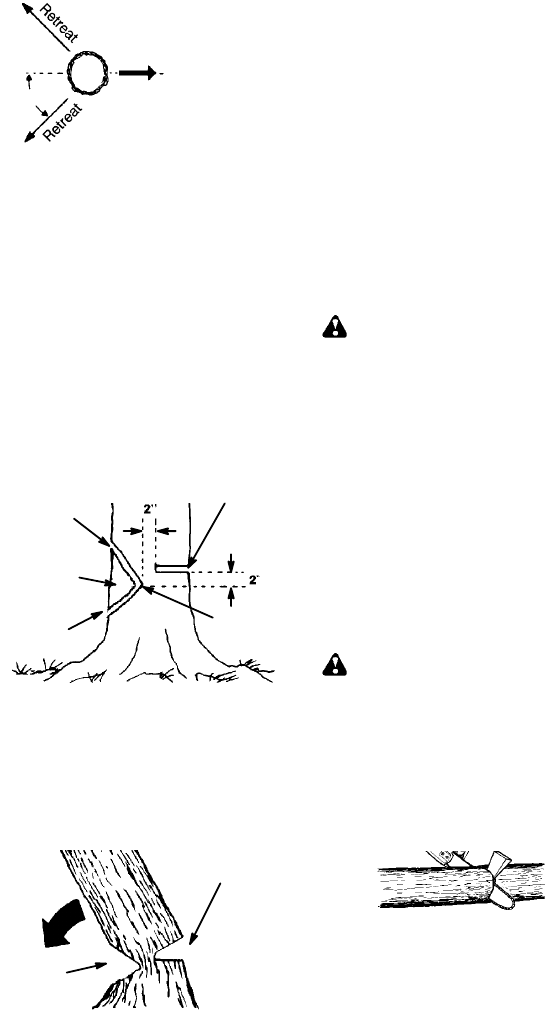
12
Plana clearretreat pathto therear and diag-
onal to the line of fall.
Direction of Fall
45_
Plan a clear retreat path
FELLING LARGE TREES
(6 inches (15 cm) in diameter or larger)
The notch method is used to fell large trees.
Anotchis cutonthe side ofthe treein thede-
sired direction of fall. After a felling cut is
made on the opposite side of tree, the tree
will tend to fall into the notch.
NOTE: If the tree has large buttress roots,
removethembefore makingthenotch. I fus-
ing saw to remove buttress roots, keep saw
chain fromcontacting groundtopreventdull-
ing of the chain.
NOTCH CUT AND FELLING THE
TREE
S Make notch cut by cutting the top of the
notch first. Cut through
1/3 of the diameter
ofthetree. Nextcomplete thenotchbycut-
ting the bottom of the notch. See illustra-
tion. Once the notch is cut remove t he
notch of wood from the tree.
Notch
First cut
Second cut
Final (felling) cut here, 2 inches
(5 cm) above center of notch.
Hinge
S After removing the wood from the notch,
make the felling cut on the opposite side of
thenotch. This isdone by makinga cutabout
two inches (5 cm) higher than the center of
the notch. This willleave e nough uncutwood
between the felling cut and the notch to form
a hinge. This hinge will help prevent the tree
from falling in the wrong direction.
Opening of
felling cut
Closing of
notch
Hinge holds tree on stump and helps
control fall
NOTE: Before felling cut is complete, use
wedges to open the cut if necessary to
controlthedirectionoffall. Toavoidkickback
and chain damage, use wood or plastic
wedges, but never steel or iron wedges.
S Be alert to signs that the tree is ready to fall:
cracking sounds, widening of the felling cut,
or movement in the upper branches.
S As tree starts to fall, stop saw, put it down,
and get away quickly on your planned re-
treat path.
S DO NOT cut down a part ially fallen tree
with your saw. Beextremely cautious with
partially fallen trees that may be poorly
supported. When a tree doesn’t fall com-
pletely,setthesawasideandpulldownthe
tree with a cable winch, block and tackle,
or tractor.
CUTTING A FALLEN TREE
(BUCKING)
Bucking is the term used for cutting a fallen
tree to the desired log size.
WARNING: Do notstandon the log
being cut. Any portion can roll causing loss
of footing and control. Do not stand downhill
of the log being cut.
IMPORTANT POINTS
S Cut only one log at a time.
S Cut shattered w ood very carefully; sharp
pieces of wood could be flung toward opera-
tor .
S Use a sawhorse to cut small logs. Never
allow another person to hold the log while
cutting andnever holdthe logwith your leg
or foot.
S Do not cut in an area where logs, limbs,
and roots are tangled such as in a blown
down area. Drag thelogs intoa cleararea
before cutting by pulling out exposed and
cleared logs first.
TYPES OF CUTTING USED FOR
BUCKING
WARNING: If saw becomes
pinched or hung in a log, don’t try to force it
out. Youcanlosecontrol ofthesawresulting
in injury and/or damage tothe saw. Stop t he
saw,driveawedge ofplastic orwood intothe
cut until thesaw canbe removed easily. Re-
startthesawandcarefullyreenterthecut. To
avoid kickback and chain damage, do not
use ametalwedge. Do notattempt torestart
your saw when it is pinched or hung in a log.
Use a wedge to remove pinched saw
Turn saw OFF and use a plastic or
wooden wedge to force cut open.
Overcutting begins on the top side of the log
with the bottom of the saw against the log.
When overcutting use light downward pres-
sure .


















